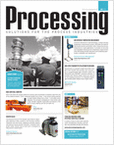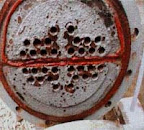Monday, July 28, 2008
Display problem ? Click HERE
Recommended :
Subscribe FREE - Processing Magazine
 Heat Exchangers are a significant part of many industrial processes that involve energy exchange. Most of these heat exchangers become fouled with use. The United Engineering Foundation, which hosts a conference every three years on the fouling problem, estimates that the cost of heat exchanger fouling is 0.4 % of global Gross Domestic Product (UEF, 2001). This high cost has lead to frequent study of the fouling problem, including numerous books and conferences on the subject (Somerscales and Knudsen, 1981; Melo et al., 1988; Bott, 1995). Much of this work has focused on particular industries. Crude oil processing, dairy and food processing, and nuclear reactor cooling are all industries that have conducted a large amount of research aimed at understanding and mitigating fouling.
Heat Exchangers are a significant part of many industrial processes that involve energy exchange. Most of these heat exchangers become fouled with use. The United Engineering Foundation, which hosts a conference every three years on the fouling problem, estimates that the cost of heat exchanger fouling is 0.4 % of global Gross Domestic Product (UEF, 2001). This high cost has lead to frequent study of the fouling problem, including numerous books and conferences on the subject (Somerscales and Knudsen, 1981; Melo et al., 1988; Bott, 1995). Much of this work has focused on particular industries. Crude oil processing, dairy and food processing, and nuclear reactor cooling are all industries that have conducted a large amount of research aimed at understanding and mitigating fouling.
Subscribe FREE - Processing Magazine
 Heat Exchangers are a significant part of many industrial processes that involve energy exchange. Most of these heat exchangers become fouled with use. The United Engineering Foundation, which hosts a conference every three years on the fouling problem, estimates that the cost of heat exchanger fouling is 0.4 % of global Gross Domestic Product (UEF, 2001). This high cost has lead to frequent study of the fouling problem, including numerous books and conferences on the subject (Somerscales and Knudsen, 1981; Melo et al., 1988; Bott, 1995). Much of this work has focused on particular industries. Crude oil processing, dairy and food processing, and nuclear reactor cooling are all industries that have conducted a large amount of research aimed at understanding and mitigating fouling.
Heat Exchangers are a significant part of many industrial processes that involve energy exchange. Most of these heat exchangers become fouled with use. The United Engineering Foundation, which hosts a conference every three years on the fouling problem, estimates that the cost of heat exchanger fouling is 0.4 % of global Gross Domestic Product (UEF, 2001). This high cost has lead to frequent study of the fouling problem, including numerous books and conferences on the subject (Somerscales and Knudsen, 1981; Melo et al., 1988; Bott, 1995). Much of this work has focused on particular industries. Crude oil processing, dairy and food processing, and nuclear reactor cooling are all industries that have conducted a large amount of research aimed at understanding and mitigating fouling.Particulate fouling of HVAC heat exchangers can lead to negative energy and indoor air quality impacts. This work investigated the mechanisms and consequences of particle deposition on fin-and-tube heat exchangers.
Jeffrey SiegelRead more...
Please constantly do heat exchanger maintenance to minimize OPEX.
Related Topics
- Heat Exchanger Fouling Mechanism, Prevention and Treatment...
- Why Lower Fouling factor in Plate Heat Exchanger ?
- Practical Design Tips for Heat Exchanger
- What type of heat exchanger can be used to handle fluid with solid ?
Labels: Heat Exchanger, Shell and Tube Heat Exchanger
